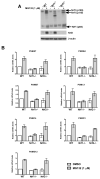Transcription factor Nrf1 mediates the proteasome recovery pathway after proteasome inhibition in mammalian cells
- PMID: 20385086
- PMCID: PMC2874685
- DOI: 10.1016/j.molcel.2010.02.029
Transcription factor Nrf1 mediates the proteasome recovery pathway after proteasome inhibition in mammalian cells
Abstract
In Saccharomyces cerevisiae, chemical or genetic inhibition of proteasome activity induces new proteasome synthesis promoted by the transcription factor RPN4. This ensures that proteasome activity is matched to demand. This transcriptional feedback loop is conserved in mammals, but its molecular basis is not understood. Here, we report that nuclear factor erythroid-derived 2-related factor 1 (Nrf1), a transcription factor of the cap "n" collar basic leucine zipper family, but not the related Nrf2, is necessary for induced proteasome gene transcription in mouse embryonic fibroblasts (MEFs). Promoter-reporter assays revealed the importance of antioxidant response elements in Nrf1-mediated upregulation of proteasome subunit genes. Nrf1(-/-) MEFs were impaired in the recovery of proteasome activity after transient treatment with the covalent proteasome inhibitor YU101, and knockdown of Nrf1 in human cancer cells enhanced cell killing by YU101. Taken together, our results suggest that Nrf1-mediated proteasome homeostasis could be an attractive target for therapeutic intervention in cancer.
2010 Elsevier Inc. All rights reserved.
Figures






References
-
- Altavilla G, Arrigo C, Marabello G, Galletti G, Santarpia M, Sauta M, Pitini V. Amplification and overexpression of the PSMB5 gene contributes to bortezomib resistance in retreatment of patients with multiple myeloma. J Clin Oncol (Meeting Abstracts) 2009;27:e19500.
-
- Andrews NC, Erdjument-Bromage H, Davidson MB, Tempst P, Orkin SH. Erythroid transcription factor NF-E2 is a haematopoietic-specific basic-leucine zipper protein. Nature. 1993;362:722–728. - PubMed
-
- Arlt A, Bauer I, Schafmayer C, Tepel J, Muerkoster SS, Brosch M, Roder C, Kalthoff H, Hampe J, Moyer MP, et al. Increased proteasome subunit protein expression and proteasome activity in colon cancer relate to an enhanced activation of nuclear factor E2-related factor 2 (Nrf2) Oncogene. 2009 - PubMed
-
- Bazzaro M, Lee MK, Zoso A, Stirling WL, Santillan A, Shih Ie M, Roden RB. Ubiquitin-proteasome system stress sensitizes ovarian cancer to proteasome inhibitor-induced apoptosis. Cancer Res. 2006;66:3754–3763. - PubMed
Publication types
MeSH terms
Substances
Grants and funding
LinkOut - more resources
Full Text Sources
Other Literature Sources
Molecular Biology Databases
Research Materials
Miscellaneous

